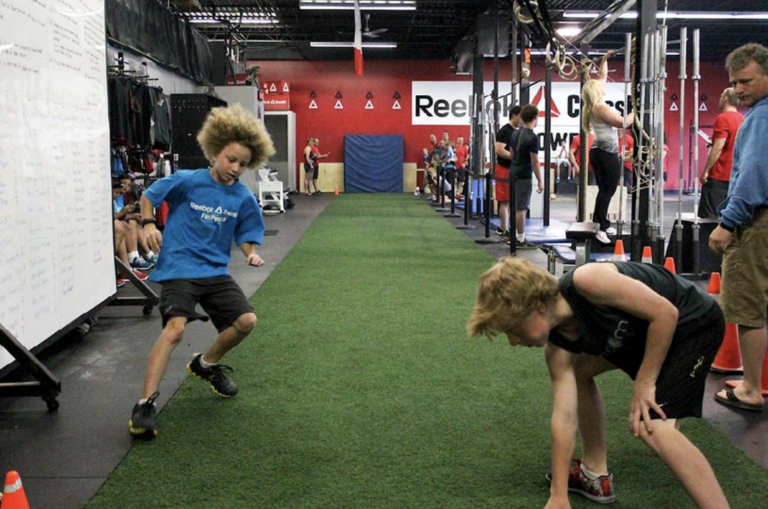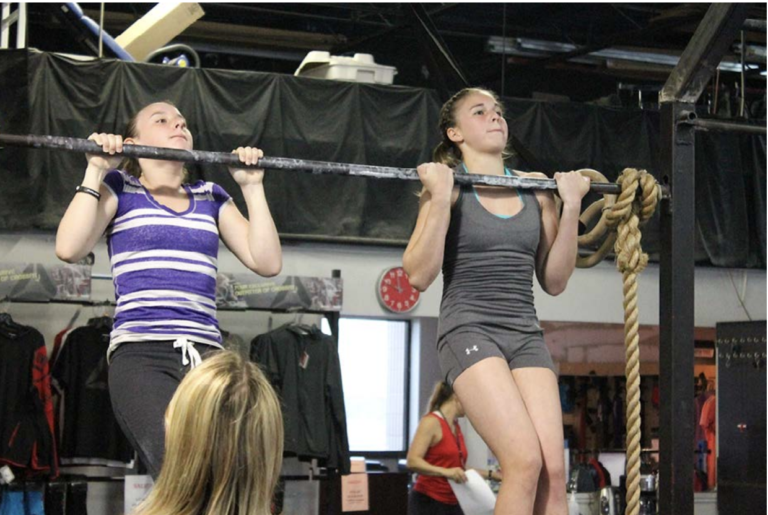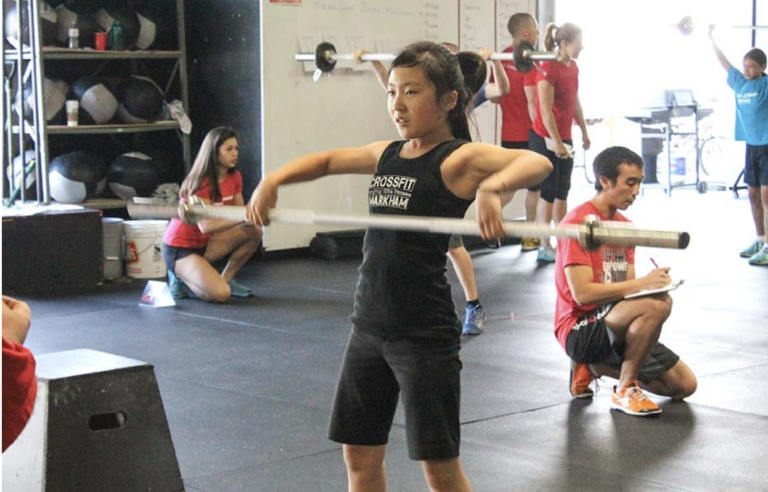Shea-Lynn Gioia is 12. She traveled for eight hours to compete in her first CrossFit event. Shea, her parents and her coach made the trip to CrossFit FirePower, a hub for CrossFit Kids seminars in Milton, Ont. Shea is joining 30 other kids aged 12-18 for one of the first CrossFit Kids Gauntlet competitions held outside California. Over two weekends in May, 10 Gauntlet events were held worldwide.
Shea identifies herself as a CrossFit athlete, though she also competes in track and field and just broke city records in the 100 meters and high jump. She also just qualified for the provincial basketball team. Shea used to dance competitively but didn’t like it and tried gymnastics with the same result.
Other athletes at the Gauntlet include an 18-year-old junior-level hockey player, a 12-year-old soccer player, and runners, volleyball players and gymnasts of various ages. Most compete in other sports; many say they’d choose CrossFit as their primary activity over their “main sport.”
Some of the top adult CrossFit athletes in the world have been training for fewer than three years. Some of these kids already have more experience. How great could these athletes become as they grow up with CrossFit?
Long-Term Investments
Jeff Martin doesn’t want a CrossFit Kids Games.
“What we’ve seen in other sports is this problem when kids are pushed to be competitive when they’re too young,” says Martin, who helped found CrossFit Kids. “That’s not what we’re about. We want to teach them to move well first. Let’s not ruin their ability to progress in the long term.”
To that end, Gauntlet events include tests of fitness that aren’t always focused on lifting.
Kids test themselves on strict pull-ups, broad jumps, shuttle runs or even pulling a sandbag.
Though you’ll see hang cleans and overhead squats from the young athletes at the Gauntlet event at the CrossFit Games, you’re also likely to see some skill tests. In past years, muscle-ups, double-unders and broad jumps have all been tested as single-modality events.

Photo by Chris Cooper
Including these skills tests provides opportunity for different athletes to shine while still determining the best athlete overall. While a young girl who’s just been through a growth spurt might have an advantage on a broad jump, her longer levers may make push-ups more challenging. Good programming for this age group will include a broad variety of movements to provide equal opportunity for every athlete to excel.
During the workouts, teens are monitored one-on-one by judges who enforce good technique and can institute mandatory rest breaks.
“We don’t want this to become like Little League,” says Martin. “We want it to remain fun. We want to choose events we can judge without necessarily requiring a child to squat fast.”
Gauntlet organizers make sure kids are suited to competition before the first event begins. That means the CrossFit philosophy of mechanics, consistency and intensity is front and center.
“What makes a kid ready for competition?” asks Martin. “Well, physicality is the first part—and it’s the easy one. Next, are they moving well? Are they mature enough to handle hearing ‘no rep!’ from an adult? Are they focused? Does every rep look the same? Some of those are harder to measure than others.”
For that reason, Martin encourages coaches to attend Gauntlet events with their teenage athletes. Though all athletes are assessed on movement standards when they arrive, the decision to move up or down in competitive class is best handled by coaches.
“CrossFit Kids coaches get what we’re trying to accomplish: moving well and safely, not just fast,” says Martin. “It’s better to have a coach stop an athlete than the referee. That’s the essence of our program right there.”
This movement-first approach will be on display at the 2013 Gauntlet event at the CrossFit Games. Some of the best movers in each age group at Gauntlet events earlier in the year received an invitation to participate in Carson. Though most of the athletes chosen for California won their division at a Gauntlet event, they were chosen by skill rather than by rank. Of course, the best movers often win.
Fun First
Standing on the sidelines of a Gauntlet event is exciting. The kids are legitimate athletes, whose passion and intensity rival that of adult Regional competitors. There’s a big difference, though: they’re having fun. That’s not to say adult CrossFit athletes don’t have fun, but competition is a bit different with a spot at the CrossFit Games on the line. While most adults are all business at the countdown, the kids approach the events with an attitude of play that’s obvious.
“Is she gonna smile the whole time?” one parent asks another after complimenting the young athlete’s thruster technique. The two parents have just met.
“Yep. Probably,” is the response.

Photo by Chris Cooper
There is no Little-Leaguing. The crowd is made up of dozens of smiling parents who are cheering but not goading or heckling umpires. A redhead is planted in the middle of the room, toes sneaking under the barricade with neck craning to see. She’s leaning over as far onto the event floor as she can, cheering for her older brother, Jake, as he does snatches. He’s small but has great mechanics, and that moves him ahead of several others. When he finishes, they do a fist bump and she sits down to watch the rest.
She wishes she were out there but will cheer for Jake for now.
“I’ve been doing CrossFit for two years now,” says Jake Underhill, who also plays hockey.
Jake was drawn to CrossFit by former NHL player Scott Thornton, who owns CrossFit Indestri. When Jake started at the gym, his mom, Sue, started with him. Though she doesn’t want to compete, she says it’s been great for Jake.
“Scott encouraged him right from the get-go,” Sue says. “He’s a little guy for his age, but he knows that he has really good form, and that gives him confidence. We see it on the rink, but we also see it in life.”
The knuckle-bumping little sister says she wants to compete, too.
“It looks pretty cool,” she says. “I’m proud of my brother.”
Building Athletes — And People
Following the CrossFit Kids mandate of “form first” has paid dividends for one of the original CrossFit Kids: Connor Martin, now 21 and a member of CrossFit’s Level 1 Seminar Staff, competed on the CrossFit Brand X Regional team in 2013. At 165 lb., he completed three unbroken sets of four 225-lb. squat cleans and rope climbs in Event 7. The majority of Regional-level men couldn’t match that feat.
Other teens brought up on CrossFit Kids programming are enjoying the benefits in other sports.
Jason Dasilva, an 18-year-old player in the Ontario Hockey League, pedals a stationary bike between Gauntlet events. He’s been coming to FirePower for seven years. Now, one step away from the NHL, Dasilva is competing in his first CrossFit competition.
“I think competing with people makes you a better person,” the Guelph Storm player says. “When I get drafted to the NHL, I’m going to find a CrossFit box in that city.”
And some young athletes have dreams of being the next Annie Thorisdottir. Abbey Smith of Australia was the youngest competitor in the 2013 Open. Smith turned 14 on the cutoff date, and her short-term goal was to complete all the Open workouts as prescribed. Indeed she did. Long-term, she’d like to make it to the CrossFit Games.
This focus on competition is attractive to some teens— especially those who might grow up considering the sport of fitness their pastime of choice. But beyond the physical, CrossFit Kids competition might have positive emotional and psychological affects on developing athletes, according to Dr. Allison Belger, author of The Power of Community: CrossFit and the Force of Human Connection. With her husband, T.J., she owns TJ’s Gym in Marin County. On April 21, 2013, the Belgers hosted the NorCal Teens event, a fitness competition that wasn’t officially endorsed by CrossFit or CrossFit Kids.
“We had 12 girls and 38 boys, and probably 500 spectators,” says Belger. “There was absolute raw and honest enthusiasm for these kids.”
The winner of the older teen categories was an 18-year-old from TJ’s Gym. Rich Froning is the background image on his phone.
In the crowd were coaches and athletes who came to watch and brought teens from their own gyms.
“Competition is so motivating for people. It’s really missing from the lives of many teens now, especially girls,” Belger says. “We had a girl who doesn’t play conventional sports who got to feel like a freaking rock star yesterday, and rightly so. She has this whole new forum for being awesome. To give that to a teenaged girl is really great.”

Photo by Chris Cooper
Dr. John Ratey, Harvard researcher and author of Spark!, reinforces the idea that competition between kids is helpful for their development. He believes competition teaches kids to operate at their limits: “The best kind is a balance of competition and cooperation. When everyone is struggling to climb the rope, but they’re cheering for you to climb the rope, you’re going to climb the rope sooner.”
Daughters Drawing in Dads
Kezia Romany brought her family with her to the Gauntlet event in Ontario. Kezia’s older sister, Jordana, is a coach at CrossFit Markham. Jordana is excited for Kezia; their mother is not.
While Kezia does burpees, her mother paces. When she does power snatches, her mother can’t watch. Afterward, Kezia is grinning; her mother is hiding.
“I like the competition even more than class,” Kezia says. “It makes you want to train harder. I want to compete in CrossFit forever.”
Jordana has noticed more than athletic improvement in her little sister.
“It’s a perfect outlet for her, because she can apply her athletic abilities and see that she’s getting better,” Jordana says. “When they compete, they can see their training put into practice. Maybe they see that they’re good at one thing or need to work on another.”
Kezia hopes to coach CrossFit someday, just like her big sister.
“I want to be a Games competitor, too,” she says.
Kezia’s mother is Fernanda. She’s not scared that Kezia will be hurt; she’s just nervous by nature.
“I knew she would do well. This has been great for her,” Fernanda says. Kezia’s passion has also helped influence her parents.
“She keeps me on my toes as to what to eat and what not to,” Fernanda says.
Kezia’s dad, Gerard, is new to CrossFit. Introduced by his daughters, he loves the workouts and their benefits in and out of the gym.
“My thing for her is that she has fun,” he says. “But it’s also helped her be more confident; she’s not scared to try new things anymore. CrossFit has brought her personality out.”
Gerard expands on his philosophy: “Success breeds success. When a kid is successful at one thing, it leads to something else, then something else … . One of the most important things you can teach your kids is that it’s OK to fail. CrossFit does that for Kezia.
Growing Up CrossFit